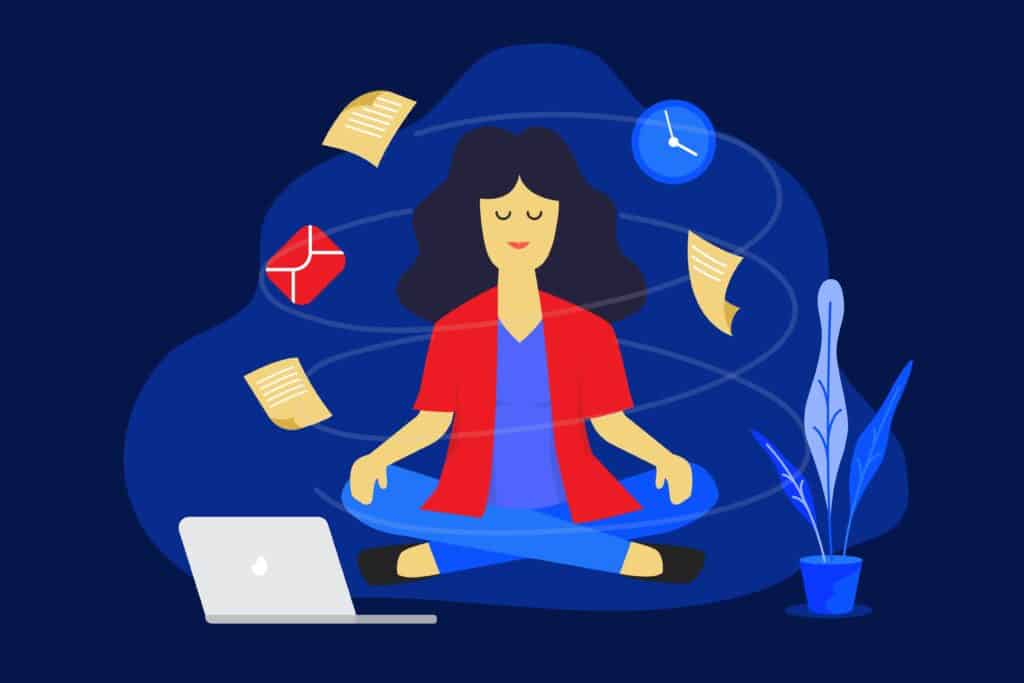
How can meditation help me be motivated in my life?
Meditation has been around since ancient times but it was only recently that it started to gain popularity among westerners. Today there are numerous types of meditation techniques. For example, mindfulness meditation focuses on being aware of thoughts and emotions while being present in the moment. This type of mediation helps individuals experience feelings without judgment.
Do you want to find a way to improve yourself every day? Do you want to discover ways to boost your self-confidence and motivation? If so, then meditation for energy and motivation could be exactly what you need!
The benefits of meditation practice:
Meditation has been proven time and time again to be effective at improving mental health. And now, thanks to new techniques, there are many other benefits too!
Some benefits include:
- Studies have shown that meditation has similar effects on our mood, to running. While running is good for health, sometimes long bouts of exercise leave you feeling exhausted. Going for a run increases our ‘feel good and happy chemicals in your brain known as endorphins (or called a ‘runner’s high) but people who practice meditation consistently get more endorphins than runners. Consistent meditation increases our serotonin which stabilizes our mood, feelings of wellbeing, and happiness.
- In terms of long-term health, meditating may be more effective than exercise. Master meditators have higher levels of endorphins and melatonin than other individuals.
- Meditation may help treat depression, pain, and stress. There are many benefits to regular meditation. This also includes increasing the grey matter within our brains which leads to greater cognitive function such as memory, concentration, focus, awareness, and attention.
- Meditation decreases the impact of the sympathetic nervous system, commonly known as the “fight or flight” response. This means that meditation improves physical health and mental clarity. In addition, seasoned meditators are more aware than non-meditators of changes occurring in the brain.
- Meditation is effective at lowering resting heart rate and blood pressure but also increasing alertness and awareness. Those who meditate consistently tend to experience more improvements than those who engage in mindfulness practices intermittently.
- Meditation increases energy and motivation because it helps us relax our minds and bodies. When we practice mindfulness meditation, we learn how to control our thoughts and emotions so they don’t get in the way of our lives. We learn to be aware of what is happening around us without getting caught up in negative thoughts.
Self-motivation and emotional intelligence:
According to emotional intelligence expert Daniel Goleman, self-motivation is a key component of emotional intelligence.
Emotional intelligence is the measure of one’s ability to recognize and manage his or her own emotions and the emotions of other people.
Self-motivation’s relevance to emotional intelligence highlights its role within our ability to understand ourselves, relate to others, and succeed in reaching our goals, Goleman states that there are four components of motivation:
1. Achievement drive, or the personal drive to achieve, improve, and meet certain standards
2. Commitment to your own personal goals
3. The initiative, or the “readiness to act on opportunities”
4. Optimism, or the tendency to look ahead and persevere with the belief that you can reach your goals.
Emotions play an integral role in motivating us to act. They motivate us to take certain actions because they make us feel good or bad. For instance, when we experience positive emotions, such as joy or happiness, we tend to want to engage in activities that produce these feelings. Conversely, negative emotions, like anger or sadness, often lead us to avoid engaging in activities that would generate them.
With all of this information, it is obvious that meditation can therefore have profound effects on our motivation as it regulates our emotions.
Motivation and Neuroscience – the brain chemical composition:

The limbic system is the part of our brain that controls behavior and emotional responses. Meditation directly influences how our limbic system operates and how our emotions are perceived and related to behavioral actions.
As stated above meditation increases our serotonin, melatonin, and endorphins which are all neurotransmitters, and change our brain’s chemical position to feeling happy, relaxed, and joyful.
One neurotransmitter that plays a role in the science of motivation is dopamine. Although dopamine is linked to feelings of ‘pleasure’ its true function is to encourage us to act – which can lead to pleasure by achieving something good or avoiding something bad. It drives our subconscious mind towards reward-based positive thinking.
In another study, a team of Vanderbilt scientists mapped the brains of “go-getters” and “slackers.” They found that people willing to work hard had higher dopamine levels in the striatum and prefrontal cortex — two areas known to impact motivation and reward. Among slackers, dopamine was present in the anterior insula, an area of the brain involved in emotion and risk perception.
Your Brain on Dopamine: The Science of Motivation
Dopamine spikes occur whenever we’re anticipating an event that might be rewarding. In general, here’s how it affects your productivity.
The brain can be trained to increase dopamine when it is paired with a rewarding experience. You create the dopamine environment, and the brain creates the internal reward system. This relates to both intrinsic and extrinsic motivation factors.
A good way to achieve those rewarding moments is by setting incremental goals. When dopamine flows through your brain, your body feels rewarded for completing each step and meeting each challenge.
Meditation and dopamine
We already know that intention setting is part of meditating and this can also be a form of creating these incremental goals that are stated above.
Meditation and mindfulness practices are known to modulate our neurotransmitters and ultimately our brain’s chemical composition. It, therefore, has great effects on our dopamine production.
Since meditation is linked to dopamine, serotonin, and endorphins which are linked to joy and pleasure which is linked to a reward system… well it seems very obvious then that the conclusion is drawn that joy and pleasure increase our motivation because we are driven towards goals that have rewards.
Meditation for motivation – How can meditation motivate us?
Meditation is one of the best ways to help us relax our minds and bring out more positive aspects of ourselves. It is also believed that meditation helps people become more aware and gain self-knowledge. This means that meditation is beneficial for anyone who wants to achieve specific goals or develop themselves.
Meditation often involves positive affirmations or intention setting and this is a powerful tool to set us up for a successful day by increasing our intrinsic motivation (motivating factors that come from internal thoughts). It gives us a direction towards our goals in a very mindful and intentional way.
The benefits of meditation include stress relief, improved mental clarity, increased focus, reduced anxiety, and enhanced creativity – to mention just a few. Meditation is also known for increasing motivation, which may be why some people attempt to use it as a tool for managing work-related stress.
Meditation increases motivation because it decreases stress. Stress causes us to become less effective at everything we do. We feel frustrated and overwhelmed when stressed out. When we practice mindfulness meditation, our body becomes calmer and clear, allowing us to be more productive.
If you’re trying to motivate yourself at work, then consider using meditation techniques or mindfulness practices such as these listed below to help you stay motivated.
5 Guided Meditations for Energy and Motivation
As you begin your day, try adding one of these five guided morning meditations for greater energy and motivation.
1. Breathing Exercises
Breathing is essential to life. When we breathe correctly, we get enough oxygen and expel carbon dioxide. We also release tension and relax our muscles. But many people don’t know how to properly breathe.
There are many different types of breathing techniques to achieve a calmer yet energized state.
Ever heard of box breathing?
Read about it here and follow our very own Box Breathing GIF below
Practice Bellows Breath for Increased Energy
Deep breathing increases energy and focus. You should be aware of your body while you practice deep breathing exercises. Deep breathing can make you feel dizzy or lightheaded. Stopping and returning to normal breathing may help relieve these symptoms.
To begin, inhale through your nose, then exhale forcefully. Then, inhale and allow the belly to expand. Exhale again and let the belly contract. Repeat these steps several times until your breathing rhythm feels natural.
Avoid reverse breathing. Breathing correctly helps you relax and feel more comfortable during meditation.
Once you have the rhythm down, you can move quickly through the breathing exercises. An emphasis is placed on the inhale while the exhale is forceful and contracted. The inhale and exhale should be similar in duration.
Aim for three breath cycles a second. Do not practice for more than 15 seconds without taking a break when you are first starting. As you become more advanced you can add 5 seconds, working your way up to a minute of practice.
2. Wake Up With a Yoga Flow or Sun Salutation for Increased Energy
Practice Yoga daily to get more energy and stay motivated throughout the day. It can simply be by starting each day with a Sun Salutation. Flow into the postures while breathing naturally and slowly. Don’t worry about achieving perfect form. Just enjoy the practice.
Each pose in a Sun Salutation brings a different mental focus to the practitioner. The mindful practice of each posture allows the practitioner to enter into a flow state as he or she moves from one position to the next. Try setting an intention of one thing you want to achieve before you start your physical practice. This allows you to tap into your motivation and direct your attention and focus on this goal that you can carry with you for the rest of the day.
3. Practice Walking Morning Meditation
Waking up early can lead to a more productive day. Even better, try waking up before sunrise to get some fresh air before work. Walking meditation can be a great way to begin a morning filled with joy and energy. Be sure to include some time walking around nature to enjoy the scenery.
A study showed that walking meditations can increase serotonin levels and produce other benefits.
Go for a walk outside and immerse yourself in nature. Walk slowly and mindfully. Feel yourself breathing deeply, feel the air entering your lungs as you inhale, and flow out as you exhale. Focus on the breath and how it feels moving inside your chest. You can do this anywhere.
Try and notice your surroundings as you walk. Become mindful of all the things you can see, hear, smell or even touch this gives our mind a much-needed rest and a fresher outlook.
This is particularly helpful if you are struggling with a creative or mental block towards something.
4. Mindful Morning Shower Meditation
Meditation should be practiced regularly. Many people claim they don’t have time to do this every day but meditation can be done whenever and wherever and incorporated into daily activities such as taking showers or doing housework. Other examples of mindfulness activities include going for walks or running errands. Anything that is done with the intent of mindfulness can be a sort of meditation.
The idea behind mindfulness is to focus on the present moment.
In the shower, focus on the sensation of the warm water as it runs down your body. Picture it washing away everything else.
Your mind tends to wander during moments of boredom or stress. Try practicing mindfulness. Concentrate on the present moment and notice what you see, hear, smell, taste, or feel. Focus on the sensations in your body while washing your hair. Enjoy the time spent relaxing.
There is a reason why many people say they came up with the best ideas in the shower – it’s because their mind was relaxed enough to be present – when our minds are relaxed we are less analytical and therefore our thoughts are focused and less all over the place.
Showering with a calming mantra or song is a great way to start the day too. For example, you might say “I am awake” as you wash the face, then move to the neck and shoulders. Continue washing until you reach the feet and finish by saying “I am calm.”
While you’re taking a shower, pay attention to each sensation of water hitting your skin. Feel the temperature of the water as it runs down your body. Notice how the warmth feels better than cold. Enjoy the feel of the soap over your skin. Imagine how pleasant it would be to wash away all of the worries and stress of the day. Allow yourself to enjoy every moment of this experience.
This shower meditation is a form of mindfulness. It does not take any extra time from your day. It is simply one way to incorporate present-moment awareness into your routine.
5. Practice Mantra Morning Meditation for Increased Energy
Om is a Sanskrit word meaning “the universe.” It is pronounced A-U-M.
Chanting “Om” is a popular meditation technique. Scientists have discovered that our brainwaves change when we repeat a mantra such as this as our bodies release chemicals called neuropeptides. These neuropeptides help improve our state of mind.
Research shows that chanting “OM” increases our awareness by activating the parasympathetic branch of the autonomic nervous system.
When “OM” is chanted aloud, it vibrates at 136.1 Hertz. This is the same frequency as everything in nature. Scientific studies have uncovered evidence to suggest that chanting OM may be related to vagus nerve activation, which assists in the rest and digest response in the nervous system. If you are new to chanting, it can be helpful to practice reciting “OM” aloud. The sound of “OM” is similar to “A-U-M” with the word being drawn out for several seconds on the exhale. More seasoned meditators may choose to focus on the word internally.
To begin, simply inhale, and on your exhale, chant “A-U-M.” You may choose to set a timer on your phone for as long as you have to practice.
Chant “Om” three times in a row to energize yourself before starting your day.
Another way to practice mantra or chanting is to use mala beads. Mala beads come from the Hindu faith and are a string of 108 beads with one larger bead at the end. Hold the mala in your left hand and begin with the first bead between the thumb and pointer finger. Each time you chant OM, move your fingers to the next bead until you reach the largest bead, also known as the guru bead.
Once you have finished, take a few moments to sit in silence and observe any new thoughts or sensations that arise.
All in all, meditation has so many benefits – far beyond what we might realize at the moment. Increasing our self-motivation is one of these vast benefits and the great thing about this is when we increase our motivation we lead by example to inspire other people around us to feel motivated too. By increasing our intrinsic motivational factors we can influence our extrinsic motivation too. A win-win-win!



